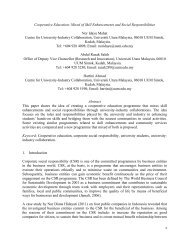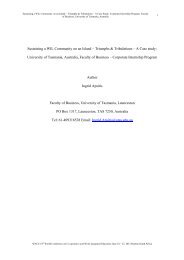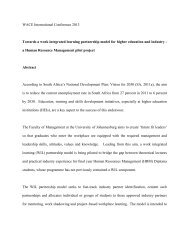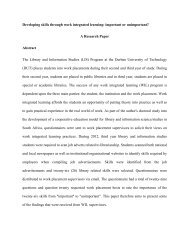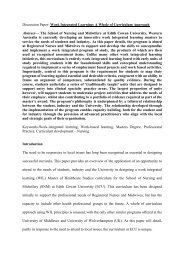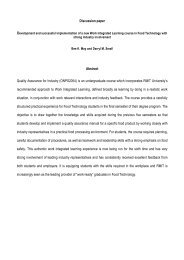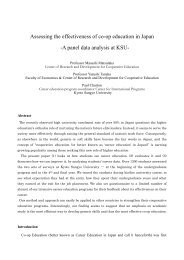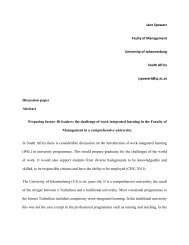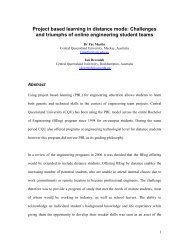Lisa Ward, Tina McAdie, Alison Bravington, Nigel King ... - WACE
Lisa Ward, Tina McAdie, Alison Bravington, Nigel King ... - WACE
Lisa Ward, Tina McAdie, Alison Bravington, Nigel King ... - WACE
Create successful ePaper yourself
Turn your PDF publications into a flip-book with our unique Google optimized e-Paper software.
IntroductionThis paper will discuss the challenges of developing and sustaining a research partnership forWork Integrated Learning (WiL). It will explore some of the issues of conducting WiLresearch and some of the practicalities of developing and sustaining a research partnership forWiL. The author will discuss getting started in research, building knowledge in the field anddeveloping resources for WiL research. Throughout the discussion paper, reference will bemade to our ongoing research projects.Why Research WiL?Work Integrated Learning (WiL) is broadly defined as educational activities that integratetheoretical learning with its application in the workplace (Cooper et al, 2010). WiL providesan authentic experience of work or professional practice in a workplace or in the community.Research in this area is particularly relevant in the light of imminent tuition fee reforms,record numbers of graduates (Browne et al, 2010), and the increasing difficulty of securingemployment post-secondary education (Chevalier & Lindley, 2009). These challenges areshared in many global economies. Universities are now challenged to design programs thatequip students with the skills, knowledge and experience that increase their employability(Bates, 2008). WiL provides a plausible mechanism to develop these skills throughplacements, sandwich education (a third year in industry in a four year degree programme)and professional training (Bates, 2008; Boud & Falichikov, 2006; Rhodes & Shiel, 2007).In a recent survey of employers conducted by the UK Chartered Management Institute(Woodman & Hutchings, 2011), three quarters of respondents felt that failures in the UK2
education system are contributing to a skills crisis in the UK. Although WiL is growing inrecognition and increasingly utilised in the UK, it has been suggested that the system ofvocational education in the UK is not well developed (Little and Lore, 2010) and has a “loosefit” with graduates’ subsequent areas of work (Little, 2001). In contrast, WiL is a wellestablished educational method in the USA, Canada and Australia.Early approaches to WiL researchMy first encounter with WiL research was back in 2007 at <strong>WACE</strong> in Singapore, whereZegwaard reported that research into WiL, up to 1997, had been ‘limited, uncertain andsparse’ (Zegwaard & Coll, 2007). Things had improved slightly by 2004, when Bartkus andStull said ‘What has been published is good’ (Bartkus & Stull, 2004). In many ways WiL hasnot been regarded as a traditional academic subject in its own right, but perspectives arebeginning to broaden: WiL research is now diverse and multidisciplinary, and there is arecognition of the potential of WiL as a pedagogical philosophy, rather than simply a modelfor facilitating links between education and work (Kjellen, 2010).More than a decade ago, Coll and Chapman (2000) explored the choices of methodologyopen to WiL researchers. In particular they emphasised the call for demonstrable quality inresearch work, and how this perhaps conflicts with the perceptions of the often self-taughtpractitioner-researcher about their own research abilities. The paper focused on theimportance of clearly articulating the philosophical underpinnings of a project, together withthe creation of a research design appropriate to the issues under investigation. Bartkus (2007)further explored the issue of research quality in the publication world outside of the knownboundaries of the Journal of Co-operative Education and Internships. The main problemappeared to be the quality of existing quantitative (i.e. statistical) research, partly the3
accuracy and appropriateness of statistical analysis, and the failure to follow acceptedconventions for research design or reporting statistical results. Limited opportunities forgeneralisation – for example because of the use of convenience sampling – were not alwaysacknowledged; small samples were also an issue, with only 13% of previous studies reviewedby Bartkus having sample sizes greater than 500. Coll and Kalnins’ more recent review ofqualitative studies of cooperative education (2009) reinforced the call for research to befirmly grounded in theory. Their paper called for data collection and analysis techniques to betransparent, evident, and audit-trailed to allow judgements to be made about research qualityquoting Guba and Lincoln’s (1989) criteria of credibility, confirmability and transferability askey issues for interpretive studies.Things are moving on with the growth of a much larger WiL research community. Much ofthis has been supported by <strong>WACE</strong> members who have organised research events aroundworld conferences and symposia, and by the re-invigoration of the two specialist journals. Inthe case of the Journal of Cooperative Education and Internships (JCEI), a new editor andeditorial board are in place, together with the open access sharing of this resource andpublicity circulated to <strong>WACE</strong> members. In the case of the Asia-Pacific Journal ofCooperative Education, successful conference tie-ins have lead to greater levels ofsubmissions, subsequent publications, and an increase in citations and an improvement inranking to a ‘B’ journal.Our research journey: getting startedThe lead author has become increasingly interested in WiL research, starting out as apractitioner-researcher discovering the benefits of WiL in terms of degree classifications,salaries and jobs (<strong>Ward</strong>, 2006). An investigation of placement journeys followed,4
documenting the triangular relationship between student, employer and institution (<strong>Ward</strong>,2009).Attending <strong>WACE</strong> conferences allowed for the opportunity to explore future possibilities forWiL research – in particular, the potentially positive psychological influence of WiL is notyet well established. Our lead researcher met with Drysdale at <strong>WACE</strong> events in Vancouverand Graz. Drysdale described the international research project which she was leading,looking at psychological influences of WiL. She had conceptualized the research project,provided the compiled questionnaire and research design, and sourced international partners.In 2010 the study had already been designed and piloted internationally across four Europeanand North American cohorts, and possibilities for the University of Huddersfield tocontribute to this project became apparent.Joining an international studyThe early literature describes the potential limitation of the role of practitioner-researchers.For our university to participate in the project, experienced local research partners needed tobe found. A core research team was formed with experience in WiL and both quantitative andqualitative research. The team of three each had busy day jobs and felt that the most could beachieved on this project with the support of a Research Assistant (RA). We applied to ourTeaching and Learning Innovation Fund for project support. Whilst the bid was successful,we compromised by taking on an RA two days a week for six months rather than for one daya week for a year. Our research, ‘Are placement students better psychologically prepared forlife and work? A quantitative study,’ formed part of Drysdale’s larger internationalcomparative study.5
Once the project was approved, a suitable RA needed to be appointed. As with all universityappointments, approvals had to be agreed and protocols followed. The core researchers spenta large amount of time complying with university recruitment procedures. The range ofapplications was good, and we were able to select an excellent RA from a strong field.However, we were immediately made aware that our RA was applying for ProfessionalDoctorates and would leave the project in six months regardless of whether the projectcontinued. Being in a position of offering only a short research contract does lead to a greaterlikelihood of staff turnover.The research contract amounted to around 40 days work. During this time there was much toorganise. Induction for the RA was condensed. A monthly steering group was set up for allthe project members to meet face-to-face. Research ethics approvals were needed, inevitablyleading to delays. Setting up the on-line survey, designing and executing a marketingcampaign and administering the survey all took time, although this was interspersed with aliterature review. The analysis phase of the research was very tight. Deadlines for conferencepapers and research bids meant that paper-writing and data analysis were carried outsimultaneously. Luckily our researcher was able to work independently with email and phonesupport from the core team, and the project deliverables were achieved.Building knowledge in the fieldFirst phase – Quantitative study resultsA total of 957 undergraduate students responded to our on-line survey investigating theimpact of WiL on a variety of psychological traits. We found that students who pursueplacements generally have significantly higher hope and confidence in attaining their goals6
and lower test anxiety than students who have not experienced placement. In addition, thiseffect appeared to be intensified by the cumulative impact of multiple work-relatedexperiences. The more work-related experiences students have the more hope, intrinsic goalorientation, confidence in attaining their goals, and academic self-efficacy they have.An area of the findings of particular interest was that of the influence of multiple WiLexperiences. Our UK findings (Purdie et al, 2011), combined with preliminary findings fromthe international study, suggest that multiple experiences may have a greater effect than asingle placement on psychological factors (self-concept, self-efficacy, hope, procrastination,tacit knowledge, and study skills/work ethic). These factors are likely to affect not onlypersonal wellbeing but also academic achievement and employability. However, themechanisms by which this may occur and the way in which multiple WiL experiences mayenhance the student learning experience over and above single placements are not yetunderstood and the evidence base is lacking. This is not to denigrate the positive value ofsingle placements, however in a time of academic reform and rapidly adapting professionallyoriented courses, multiple placements are becoming more common and a greaterunderstanding and evidence for their impact is essential.Second phase – Qualitative studyThe project was fortunate to secure further innovation funding for ‘The more the merrier? Aqualitative examination of the contribution of multiple WiL experiences to student learning,personal development and preparation for employment.’ The second phase of our researchstarted in early 2012. We have another RA in post and are starting to formulate our researchdesign and seek ethics approval. Once again we are looking at the sustainability of our7
project. During this period we have submitted two conference abstracts, a research bursaryapplication to allow an investigation of the links between psychological factors and graduateoutcomes, and have submitted a bid for a funded PhD to extend our research into placementexperiences using a mixed methods approach.Discussion of issuesResearch design: mixing methodsAttending to quality in research demands that the epistemological underpinnings of a projectshould be clear and unambiguous (Bartkus, 2007; Coll & Kalnins, 2009): is the premise ofthe project to discover ‘objective’ truths using measurement and statistical techniques, or toinvestigate subjectivity and personal meanings? Coll and Chapman (2000) suggest that someresearch questions may be best addressed by using a mixed methods approach, and that thisdoes not necessarily compromise the philosophical basis of a project. They argue thatquantitative and qualitative methods are not incommensurable – that quantitative researchusing surveys depends upon the subjective choice of appropriate statistical tests and theinterpretation of results. Subjectivity is acknowledged in qualitative research, and in order toinvestigate students’ experiences in depth, our qualitative study takes the epistemologicalstance of constructionism – the idea that meaning is not discoverable as ‘fact’, butconstructed by human beings in their engagement with the social world (Burr, 2003).The first and second phases of our project, drawing on both quantitative and qualitativeapproaches, fit neatly together. The survey gave us an understanding of the psychologicalfactors attributed to WiL. The issue of sample size has been successfully addressed with a8
large cohort of respondents and more than 700 fully completed surveys. The widerinternational comparisons benefit from an even larger sample size. The qualitative study willtease out some of the experiential detail associated with the survey results and allow us to setthem in a richer context through focus groups and individual interviews with placementstudents. It will take its focus from the quantitative analysis, which shows that WiL is mostinfluential when students consistently build on the gains they make through multipleplacement experiences (Purdie et al, 2011). We aim to research what it is about multipleexperiences that increases the benefits – in particular the student perspective on theadvantages of multiple placements in comparison to few placements.With an eye to research quality, we hope that triangulating our data using different methods –a survey, focus groups and individual interviews – will allow confidence in our findings. Colland Chapman (2000) point out the benefits of a flexible approach to research design,allowing for alterations as the project progresses, keeping the research process dynamicrather than static. Each stage of our project is being used to inform the next: issues raised inthe survey results will be addressed directly in the individual interviews and focus groups,which will address the perceived differences between multiple WiL experiences and singlework placements on participants’ learning, personal development and employability duringtheir time at university. The use of reflective tools intended to elicit interviewee’s perceptionswith minimum investigator bias has now been piloted in individual interviews, and a suitabletool has been developed to directly address the aims of the research. The analysis process willbe comprehensively audited, and this process transparently described in any future academicpapers arising from the project. It is hoped that the results of the qualitative project willresonate with readers in the field of WiL and demonstrate a level of transferability. Ourdissemination strategy of sharing findings allows for interested parties to discuss and question9
our results, and make their own informed decisions about whether the findings can beusefully applied in other situations.Developing resourcesIssues of sustainabilityThe sustainability of the project was a major issue. At a local level, difficulties faced byresearchers include managing projects alongside busy ‘day jobs’ and maintaining continuityas team members change. Throughout the first project, there was always the knowledge thatwithout further funding, our efforts in establishing the core research team and our findingswould not be realised. Therefore focus for the core team was primarily around fundingactivity. We submitted three research bids. Each of these bids, required lots of reading,preparation and a team-based approach to drafting. In some cases it was a challenge to matchwhat we really wanted to do with what bidders were looking for.Reflecting upon the external bidding activity that we did, was this the best use of time andresources? It gave us the opportunity to develop our research ideas. Yet had we spentequivalent time on our project perhaps another journal article or conference paper would haveemerged. The search for potential funding continues. Our hopes are currently on theapplication for a funded PhD stipend. This would allow the existing RA to become a PhDresearcher, thereby ensuring project longevity.The core team’s decision to work with Research Assistants had consequences for the project.On a positive note, it ensured a drive and momentum to the project, someone with time toexplore the issues and to draft papers. With an RA in the post, the project was full steam10
ahead with co-ordination, research, publication and dissemination all pursued simultaneously.Our research outputs have undoubtedly been increased with this approach.However there are some consequences to this approach as the project suffered from a stop, goapproach with ideas generated, then paused whilst funding was found. An even moreimportant factor was that the RA was the ‘expert’ on the data collected. That knowledge wentwith her. We have done our best to accommodate this with clear handover files andindividual responsibilities for the core research team.YearOneYearTwoJan Feb Mar Apr May Jun July August Sept Oct Nov DecPhase 1RA recruitmentPhase 2 bidwriting&reviewInternal recruitmentprocessesPhase 1 bid-w riting &reviewInternalrecruitmentprocessPhase 2RA recruitmentPHASE 1: SURVEY STUDYASETConferenceICEEPSYconferenceUALLAGMBPSconferenceYearThreeASET bursaryapplicationAw ait OutcomePHASE 2: INTERVIEW STUDYTeaching &LearningConference<strong>WACE</strong>conferenceJCEIJournalsubmissionASETconferenceACENconferenceFunding bidsRecruitmentFigure 1: Developing and sustaining the research project.Research Assistant in postDissem ination11
Challenges of cross-boundary workingPeach et al (2011) argue that boundary spanning is an area of theory and practice with greatapplicability to a better understanding of the activity of WiL departments. Boundary spannersare people with a wide array of contacts and exceptional interpersonal skills, and are effectivecollectors and disseminators of information. Successful boundary spanners are trusted andrespected by diverse stakeholders and they understand the social and organisationalcomplexities of collaboration. They convene diverse and eclectic partners, assemblingapparently disparate groups around shared concerns. The concept of boundary spanning canalso be applied to research partnerships bridging local and international boundaries, andreflects the importance of collaboration and dissemination in moving towards sharedunderstandings and new ideas.At a global level, one of the most significant challenges of the research project describedabove has been ensuring a partnership approach by developing working relationships acrossinternational boundaries. Our relationship with the larger international project was mainly byemail. Whilst in the early stages this facilitated communications, it also meant that for shortdeadlines such as research conferences there was not much time for consideration of theproject partners’ needs and ensuring consistency across the projects.At a local level, a major challenge faced in work related programs is developing structuresand processes across boundaries that assist stakeholders to cross social and cultural bordersbetween education and work. While boundary spanning is contextualised withinorganisational systems and structures in university departments responsible for work relatedprograms (Miller, 2008), i.e. Work Integrated Learning (WiL) and Cooperative Education(Co-op), it could be argued that the concept includes not only the facilitators who buildbridges between education and work, but also the students who cross these bridges. Our12
esearch reaches across academic boundaries in addressing these issues. Project expertisespans two academic centres, with lead members drawn from the university’s Teaching andLearning Institute and the Centre for Applied Psychological Research. Both phases of theproject span multiple academic schools and models of WiL, taking an overarching viewacross work integrated learning in its many different forms. Findings will be disseminated atboth local and international levels.ConclusionOur vision of what we can research, how we can research it, and where we should share ourfindings has been affected by the key factors described in this paper. We have discussed themultidisciplinary, multi-method nature of current WiL research, and placed the issues ofresearch quality, effective partnerships and timely dissemination at the heart of the researchprocess. The comparability and potential transferability of research findings can be informedby collaboration across international boundaries. The paper has also examined the importanceof sustainability, weighing this against the time spent recruiting part-time team members andbidding for continued funding, and describing how this impacts on time allotted to researchactivities. All of these factors affect our activities at a local level, and will inform our futureapproach to practitioner-led research.ReferencesBartkus, K.R. & Stull, W.A. (2004) Research in cooperative education, in R. K. Coll & C.Eames (Eds.), International handbook for cooperative education: An internationalperspective of the theory, research and practice of work-integrated learning (pp67-81).Boston, MA: World Association for Cooperative Education.13
Bartkus, K.R. (2007) A review and synthesis of scholarly research in cooperative educationand internships: Part 1. An analysis of quantitative research published outside the Journal ofCooperative Education and Internships, Journal of Cooperative Education and Internships,41(1), pp56-96.Bartkus, K.R. & Higgs, J. (2011) Research in cooperative and work-integrated education, inR. K. Coll & K. E. Zegwaard (Eds.), International handbook for cooperative and workintegratededucation: International perspectives of theory, research and practice (2nd ed.,pp73-84), Lowell, MA: World Association for Cooperative Education.Bates, M. (2008) Work-integrated curricula in university programs, Higher EducationResearch and Development, 27(4), pp305-17.Browne, J., Barber, M., Coyle, D., Eastwood, D., <strong>King</strong>, J. & Naik, R. (2010) Securing asustainable future for Higher Education: An independent review of higher education fundingand student finance, London: Department for Business Information and Skills. Accessedonline at: http://www.bis.gov.uk/assets/biscore/corporate/docs/s/10-1208-securingsustainable-higher-education-browne-report.pdfBoud, D. & Falchikov, N. (2006) Aligning assessment with long-term learning, Assessmentand Evaluation in Higher Education, 31(4), pp399-413.Burr, V. (2003) Social Constructionism, London: Routledge.Chevalier, A. & Lindley, J. (2009) Overeducation and the skills of UK graduates, Journal ofthe Royal Statistical Society, 172(2), pp307-37.Coll, R.K. & Eames, C. (2000) The role of the placement coordinator: An alternative model,Asia-Pacific Journal of Cooperative Education, 1(1), pp9-14.Coll, R.K. & Chapman, R. (2000) Choices of methodology for Cooperative EducationResearchers, Asia-Pacific Journal of Cooperative Education, 1(1), pp1-8.Coll, R.K. & Kalnins, T. (2009) A critical analysis of interpretive research studies incooperative education and internships, Journal of Cooperative Education and Internships,43(1), pp1-14.Cooper, L., Orrell, J. & Bowden, M. (2010) Work Integrated Learning: A guide to effectivepractice, London: Routledge.Drysdale, M. & Johansson, K. (2011) A scientific approach to research design and quality incooperative and work-integrated education, in Coll, R.K. & Zegwaard, K.E. (Eds.)International handbook for cooperative and work-integrated education: Internationalperspectives of theory, research and practice (2nd ed., pp85-97), Lowell, MA: WorldAssociation for Cooperative Education.Fransella, F. (2005) The Essential Practitioner’s Handbook of Personal ConstructPsychology, London: John Wiley & Sons.14
Guba, E.G. & Lincoln, Y.S. (1989) Fourth generation evaluation, Newbury Park: SagePublications.Kelly, G.A. (1955) A Theory of Personality: The psychology of personal constructs, NewYork: Norton.Kjellen, B. (2010) Cases as boundary objects: transfer and authenticity in work-integratedlearning, Journal of Cooperative Education & Internships, 44(2), pp26-31.Little, B. (2001)Reading Between the Lines of Graduate Employment, Quality in Higher Education, 7(2),pp121-29.Little, B. & Lore, A. (2010) Less time to study, less well prepared for work, yet satisfied withhigher education: A UK perspective on links between higher education and the labourmarket, Journal of Education and Work, 23(3), pp275-96.Miller, P.M. (2008) Examining the work of boundary spanning leaders in communitycontexts, International Journal of Leadership in Education: Theory and Practice, 11(4),pp353-77.Peach, D., Cates, C., Ilg Baden-Wuerttemberg, B., Jones, J. & Lechleiter, H. (2011)Responding to Rapid Change in Higher Education: Enabling University DepartmentsResponsible for Work Related Programs Through Boundary Spanning, Journal of CooperativeEducation and Internships, 45 (1), pp94-106.Purdie, F., <strong>McAdie</strong>, T., <strong>King</strong>, N. & <strong>Ward</strong>, L (2011) In the right placement at the right time?An investigation of the psychological outcomes of placement learning, Procedia - Social andBehavioral Sciences, 29, pp717 –24.Rhodes, G. & Schiel, G. (2007) Meeting the needs of the workplace and the learner throughwork-based learning, Journal of Workplace Learning, 19(3), pp173-87.<strong>Ward</strong>, L. J. (2006) Graduate Employment Links to Sandwich Year Work Placements. In:Changing Student Choices. A Joint Higher Education Academy and Higher EducationCareers Service Unit Conference, July, 2006, University of Manchester, UK.<strong>Ward</strong>, L. (2009) Student placement journeys: An on-line collection of video resourcesshowcasing the development of students on one year work placements with views from theiremployers and placement tutors, Proceedings of the 16th World Conference on CooperativeEducation, Vancouver, Canada: World Association for Cooperative Education.Woodman, P. and Hutchings, P. (2011) Tomorrow’s Leaders, London: CharteredManagement Institute.Zegwaard, K.E. & Coll, R.K. (2007) Publishing research and accessing establishedknowledge for cooperative education, Proceedings of the 15th World Conference onCooperative Education, Singapore City, Singapore: World Association for CooperativeEducation.15
AcknowledgementsWe are grateful to Dr. Maureen Drysdale at the University of Waterloo, Canada forconceptualizing the project, providing the compiled questionnaire with their research design,and for our inclusion in the international Work Integrated Learning project of which thisstudy forms a part. We are also grateful to Karsten Zegwaard for recommending appropriateliterature in this area.16



